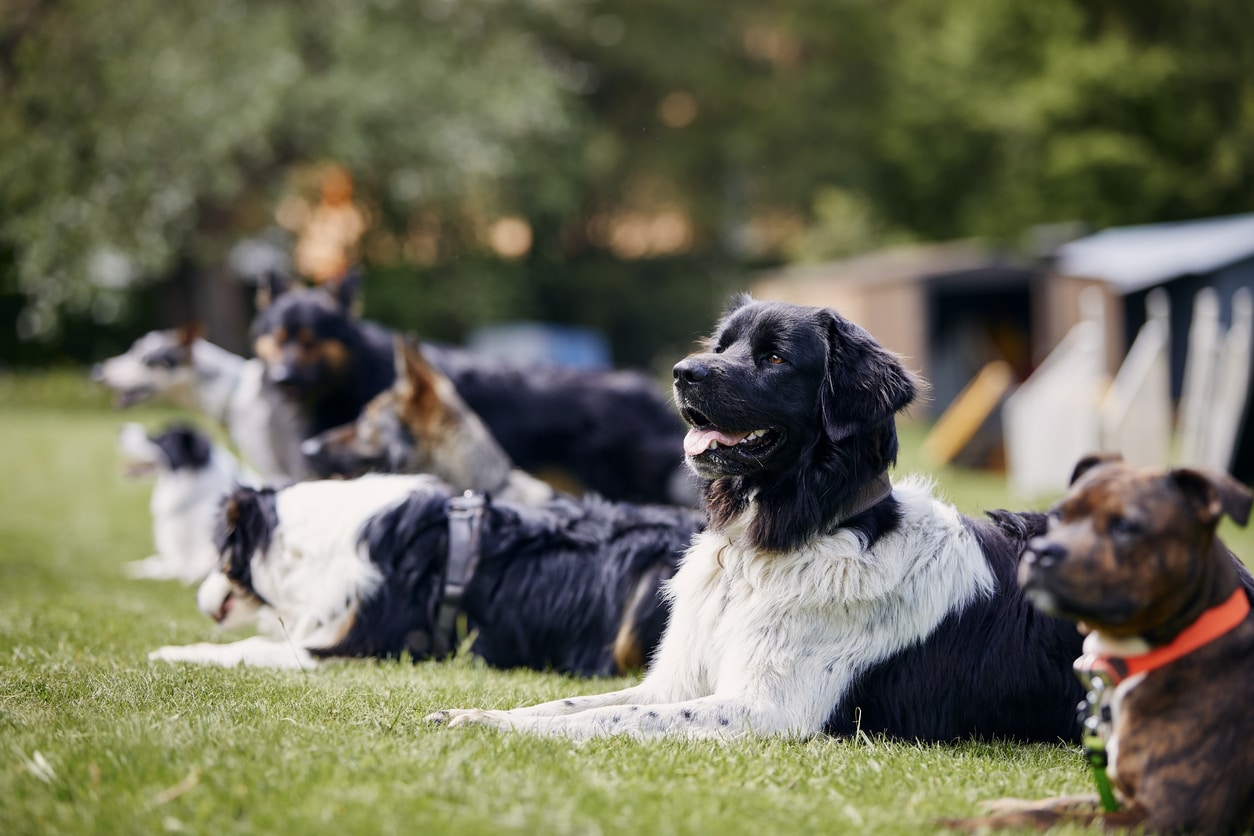Several factors must be considered when selecting a dog for your family. Including the ages of family members, family dynamics, activity level, housing situation, financial stability, and daily schedule. This article aims to provide guidance and clarity, helping you feel more confident in making the right choice during your search for the ideal dog. Whether you are looking to adopt from a rescue, or purchase from a reputable breeder, it is important to review the dynamics of your personal life before bringing a dog into your home.
Why Family Member Age Matters
If you are a parent or live with children it is important to consider the children’s age and how the environment will be managed to keep both the dog and child safe. With infants and toddlers, it is a given that the dog will be exposed to random noises, some of which will be high pitch. Also consider that infants and toddlers do not always follow the rules. Now remember, a dog and child of any age should never be left together unattended. However, even under supervision an infant or toddler may find a chance to invade a dog’s personal space and make the dog uncomfortable. If you adopt a sensitive dog who may have had a traumatic past, this may lead to a bigger problem. Whereas if you adopt a happy go lucky and tolerant dog, you will have time to mitigate the situation. This is not to say that a sensitive dog does not deserve a home, but more so to point out that they will need more guidance in a home with children. It is up to you if you are willing to put in the extra effort it takes to raise a child alongside a dog that is less tolerant of a child’s antics.
Even children who are above toddler age will unknowingly test the waters of a dog’s tolerance levels. Especially if they have yet to be educated on how to respect a dog’s boundaries. Many breeds are selectively bred to have a more tolerant demeanor, whereas others are bred to be more cautious and less tolerant. For example, a King Charles Cavalier is more likely to enjoy getting affection from a child than a Shiba Inu. Of course, dogs are individuals and have varying personalities. So, it is always important to meet the dog of your choice before bringing them home!
On the other end of the age spectrum is considering older people who may live in the home. What will their interactions be with the dog and are they going to be the main care taker? It is important to remember that as we humans grow older, our skin gets thinner and our bones get more brittle. It would be advisable to avoid medium to large energetic breeds while you have an elderly person in your home. This is for the person’s safety and quality of life. I have worked cases where older persons in the family are negatively affected by having a dog that was too much for them and the dog was brought to live in the home without their consent. However, if proper management and training are going to be put in to place and the older person is in agreement to brining an energetic dog of a medium to large size into the home, then this combination can work.
Family Dynamics
It is common knowledge that bringing a living creature in to your home is a big responsibility to take on. Now think about who in your house is the person that is going to be in charge of taking care of the dog? Who will exercise, feed, water, pay vet bills, train, and manage the dog on a daily basis? No one should decide for anybody but themselves that a dog is now their responsibility. Having children help with the care of the family dog is a great way to teach responsibility and compassion. However, do not adopt a dog with the intent of the child being fully in charge of the dog’s care. This often leads to dogs being rehomed, and/or not properly cared for. An adult should always be the main care giver of the dog.
If multiple adults are in the household, then everyone should be in agreement of what kind of dog will be brought in to the home. Having the whole family in agreement to what they want out of a dog will make the placement more harmonious with minimal complaints. It is a good idea to have a family meeting, at the very least between all adults in the home, to discuss where the dog will fit within the current family dynamics.
Another important factor to consider is any current resident dogs. Do you already have a dog in your home? If so, how do they interact with other dogs? What is their age and personality like? Some dogs adapt well to new companions, while others can be more selective. Be sure to look for a companion dog that is more likely to compliment your current dog’s personality. It is difficult to live in a multi-dog household where the dogs are unhappy with each other.
It’s crucial to evaluate your current dog’s temperament and stage of training before introducing another dog. If your existing dog isn’t fully trained, adding a new one could mean both dogs will need additional training. Be honest with yourself about your readiness to handle this situation. If you feel prepared to add another dog, make sure to research the best practices for introducing new dogs to each other to ensure a smooth transition.
Activity Level
Be honest and reflect on your family’s activity level. Do you and your family prefer to lounge at home, only going on occasional short walks? Or does your family go out on hikes often and enjoy boating trips too? Maybe your lifestyle is more in between these two extremes. Your dog should complement your activity level and should not be the opposite. If they are, preferably they be lazier than you! Someone who wants a marathon partner should look more in to adopting a dog like a Australian Shepherd or Staffordshire Terrier. Whereas a couch potato’s best match would likely be an English Bulldog or Shih Tzu.
Do note, that even lower energy dogs require exercise and behavioral issues will arise without the proper energy outlets. Your personal activity level will also affect the way you approach training with your dog. If you bring home a dog that has an unknown past and they may need extra guidance on how to behave, then you will be spending extra time and energy on training with this dog. If you bring home a puppy, they will need you to spend extra time and energy to give them the proper guidance they need to be well behaved. So, be honest with yourself about how much energy you are willing to put into training your new family member.
Housing Situation
Whilst imagining a new dog in your home, imagine how they will fit. Large breed dogs take up a lot of room and it is smart to consider how comfortable you are with giving the majority of your space up for your new family member. Be fair in your planning, as some dogs do not cope well with small living spaces, especially with multiple dogs. Of course, some of this is personality based, but some breeds are more predisposed to being territorial than others. So, doing your research on breed dispositions is important.
If you live in a small home or apartment, how much free time are you willing to spend to take the dog out for exercise if they are a medium to high energy level dog? When you have a small fenced in yard, or no yard at all, then it may be necessary to take more walks than you would if you had acreage. If you live in a multi-unit building, or in close proximity to neighbors, you may want to avoid any breeds that are known to be loud; like the Husky, Beagle, or German Shepherd. This should be considered because several noise complaints can lead to eviction if you live in a rental.
Financial Stability
Bringing a dog into your home will impact your budget for the next 12-18 years. Expenses such as food, toys, bedding, routine vet visits, emergency medical care, and the replacement of chewed items and furniture can add up. It’s wise to establish a dedicated budget for your new family member to manage these costs and prevent unexpected expenses from straining your finances. Review your overall budget and determine how much you are prepared to allocate for the dog’s ongoing needs.
Daily Routine
Reflect on your daily routine and consider where in your daily routine will your new family member fit. Are you too busy in the morning getting the kids ready for school to make time to get a puppy out for a potty break, breakfast, and playtime? Are you a full-time college student and have to work a full-time job as well? Do not put too much responsibility on your plate, and consider how much you are able to handle during your routine. It is easy to get a dog on a whim because you need companionship, but it is unfair to the dog if you do so without considering what the dog’s routine is going to look like.
We all want to give our pets the best possible life we can give them. The first step is to build a healthy routine for the whole family, including our furry members. So, consider where in your routine do you have flexibility to make time for walks, training, and playing with your dog. It is great if you have others in the family willing to help with caring for the dog too, especially when you have a busy schedule.
Conclusion
Choosing the right dog for your family involves careful consideration of various factors, from the ages of family members and overall dynamics, to activity levels, housing conditions, and financial commitments. By reflecting on how a new dog will fit into your lifestyle, daily routine, and living space, you can ensure a harmonious addition to your home.
It’s essential to be realistic about the time, effort, and resources you can dedicate to a dog, whether you are adopting from a rescue or purchasing from a reputable breeder. Thoroughly evaluating these aspects will help you select a dog that not only matches your family’s needs but also enriches your lives. Remember, a well-chosen dog can bring joy and companionship, while a thoughtful approach ensures that both your family and your new pet can thrive together.

